| Reviews & Columns |
|
Reviews DVD TV on DVD Blu-ray 4K UHD International DVDs In Theaters Reviews by Studio Video Games Features Collector Series DVDs Easter Egg Database Interviews DVD Talk Radio Feature Articles Columns Anime Talk DVD Savant Horror DVDs The M.O.D. Squad Art House HD Talk Silent DVD
|
DVD Talk Forum |
|
|
| Resources |
|
DVD Price Search Customer Service #'s RCE Info Links |
|
Columns
|
|
|
Once Upon a Time in Anatolia
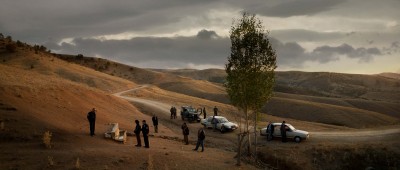
Please Note: The images used here are promotional and are not taken from the Blu-ray under review.
In the midst of Turkish writer/director Nuri Bilge Ceylan's (Climates, Three Monkeys) epically restrained crime drama/road trip of the soul, Once Upon a Time in Anatolia, its ostensibly central murder-investigation plot takes one more in a series of strange, elliptical, apparently irrelevant or meandering turns. It's the middle of the night, many kilometers outside of the nearby town, and vehicles containing police, diggers (for an expected corpse?), a public prosecutor, two murder suspects, and a doctor have for hours been winding their way along desolate roads through the vast, empty, still fields and hills of Turkey's countryside. Whether Kenan (Firat Tanis), the suspect giving directions to what we presume is the scene of the crime or the body is drunk, conscience-stricken, or cynically delaying the final proof that will incriminate him, he seems to be incapable of leading this official team of authorities bureaucrats to the place he claims to remember. The cars have stopped to shine their high-beam headlights out into another patch of darkness that's likely another dead end, and while the police chief and the prosecutor bicker pettily about what's to be done to cut to the chase with their mostly impassive, possibly malingering guide/prisoner -- what the correct procedures are, etc. -- one of the police underlings takes the opportunity to shake the fruit from a nearby apple tree. The apples rain down, he can't possibly gather them all, and suddenly we cut from this action to track one of the stray apples as it rolls all the way down the hill and into a creek, where it's carried along until it reaches the spot where several others of the fallen fruit have jammed and are rotting. And all this while the talk about the minutiae of the procedure of investigation continues, audible from off-camera.... This very bold digression repeats itself in several forms during the film, but its sheer beauty, its unapologetic invitation to multiple symbolic/metaphorical readings, and the contrast it creates between the "story" and what's really going on in the film, make for probably the most noticeably sublime, most telling moment -- the one that gives us the most evident key to unlocking Ceylan's masterful, audacious leap (if he hadn't made it already) into the highest cinematic pantheon.
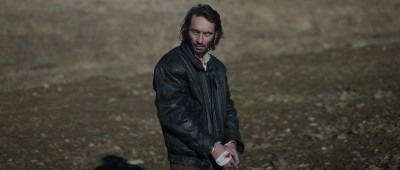
Even before that rich, telling moment, the film has opened, in a pre-credit sequence, on a dirty, wet window through which the camera ever-so-slowly tracks, finally shifting focus to let us see the garage-like den inside, which contains three drinking, card-playing male figures whom we later realize comprise the two forlorn suspects driving through the night in search of the place where the murdered and buried third man can be found and dug up for medical confirmation, evidence-gathering, and autopsy. The slowness and uncertainty of this bravura opening reveal are maintained, reiterated in various ways both subtle and forefronted, throughout the rest of the film, which, as I've suggested, consists mainly of digressions, delays, stalls in the lockstep police procedural that gives it what appears to be its principal narrative and plotline. The time span is one night and one morning -- a night spent on that meandering, frustrating, seemingly endless search for the murder victim's body, a morning passed dealing with its necessary clinical and official cataloging and disposal. But unlike its weary searchers, the film is in no hurry to be done and get out of there, insisting instead on giving us the rambling, distracted small talk of the Commisar Naci (Yilmaz Erdogan), his police underlings, and his driver (Ahmet Mumtaz Taylan) as they pass the time, dull time-filler that also draws in the more reflective Prosecutor Nusret (Taner Birsel) and Dr. Cemal (Muhammet Uzuner). To hear them, this group is little more than petty office-gossips and bureaucratic climbers, jostling for favor and position and resentful of being taken so far out of town for what seems to them such a pointlessly delayed search. Viewers might reasonably wonder why these long discussions about village politics and where to get the best traditional yogurt, or the police chief's incidental conducting of prescription business with the doctor -- all of which seem irrelevant if not actually inappropriate given the circumstances (though no less "realistic" for that) -- should be indulged so freely.
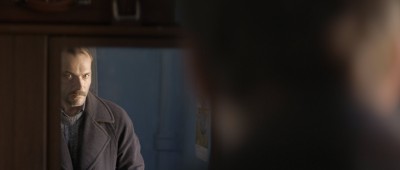
But those out-loud conversations belong to the surface police-procedural plot, and Ceylan means to demonstrate the crust of banality that tends to form around such familiar proceedings before he begins to edge us away from it, slowly, slowly allowing the silences (as when, in a shot that will cause cinephiles to swoon, he tracks in, past the conversing Arab and Commissar Naci and Dr. Cemal, to rest onto the suspect sitting stone-faced and silent in the back seat of the car); the very tentative but slightly less guarded exchanges of more meaningful words; and even what seem to be voiced-over, interior thoughts and visions (adding an air of magical realism, since Ceylan does not signal or mark off these moments in a way that would break his film's steady, entrancing rhythm) to take over the film, along with events like the episode with the apples or a sudden close-up on a flickering lamp amid a power outage that occurs when the travelers have stopped off in an outlying, poor village for tea. All this straying from the crime story reveals the distress, the roiling emotion, the concerns and the troubles that all the officiousness and procedural bickering and small talk and by-the-book following of protocol are meant, through unconscious habit, to mask and keep at bay. The doctor and the prosecutor -- who are the closest thing to principal characters in a film that nimbly spans the not immediately apparent depths of most of the group -- have the most authority and gravitas in the situation in which they find themselves, but they are in more profound terms the most adrift; attention to all the details Ceylan gives us through in the minute details of performance and the ways those details are cinematically emphasized, shows us that these are horribly lonely men, blinded by losses in their lives that they can barely articulate to themselves, let alone each other, though they do make faltering attempts to speak of their lost loves and families and hopes in a sort of nonchalant verbal code.
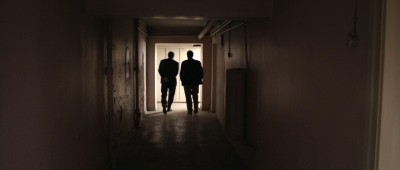
But it's not at all through speech that Ceylan lets us know what Once Upon a Time in Anatolia is really "about." He's a born, instinctive filmmaker for whom words are incidental and everything that can be told through the making and manipulation of images (done here by Ceylan's usual cinematographer, Gökan Tiryaki, working in high-def digital video as cinematically employed as you've ever seen it, with Ceylan himself working as principal film editor) must be told that way, and that way alone; he knows cinema is a visual and temporal medium whose deepest effects can easily be weakened or destroyed by too many words or over-accentuating cutting, and so the easily-recounted story of a crime committed, solved, and prosecuted that might seem to lie at the center of the film is utterly decentered. It is instead the other investigation Ceylan is conducting, the one into the much murkier territory of the verbally inexpressible, tortuous inner landscape of memory and emotion, that is the film's real, compelling reason for being, and the director conducts it through the camera's infinitesimally fine-calibrated relationship to the characters, whether he's filming them in extreme close-ups and holding, Bergman-like, for us to read the emotion on an actor's face; slowly tracking in from behind onto a bowed, pensive head; or framing people in vast, spacious, empty panoramas of sky and land (or, in town, amid buildings, pavements, and other infrastructure) that seem to dwarf them and underline the smallness and powerlessness evoked by the inexplicable horror of the crime they're investigating and wrapping up with such regulatory impersonality. This is a film with virtually no direct spoken exposition and absolutely no emphasized revelation at all, but what emerges through its supremely controlled images, montage, duration of shots, and surpassingly rich, subtle performances is nothing short of momentous. There is, in fact, a shattering, unforgettable climax at the end, but it occurs, again, virtually wordlessly, without the pushy emphasis that would rob it of its extraordinary power. In Once Upon a Time in Anatolia, every important connection is so subtle that you will certainly miss what's truly relevant if you're not watching closely and carefully; it's a demanding, challenging film that requires (and, with its superlative visual beauty, entices) your full, undivided scrutiny. But the rewards are absolutely phenomenal, rare in any medium and far out of proportion to any effort they might require to discern and glean. Rarely will you have been so glad or felt it so worthwhile to set aside any lesser, mundane distractions and keep your attention from wandering in order to experience something with so much to offer to the very fullest.
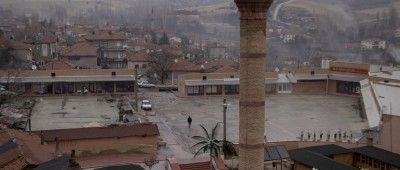
THE BLU-RAY DISC:
Cinema Guild presents Once Upon a Time in Anatolia, at its original 2.35:1 widescreen aspect ratio, in an impeccable AVC/MPEG-4, 1080p transfer. The film was shot on high-definition digital video, and the suitability of that media for digital home editions (coupled with the Guild's typical extra-special, conscientious care of the film in its charge) means that this transfer looks literally flawless: every color and skin tone looks just as it should, the nighttime darkness of the first half of the film is solid and never washed-out.... Every frame is just stunningly vibrant, and there is no aliasing or edge enhancement within miles of this lovingly prepared Blu-ray edition.
Sound:The sound on either audio option (HD Master Audio 5.1 surround or 2.0 stereo, in Turkish with optional English subs) is just about as superb as the video presentation, with every dimension of the sound perfectly mixed and accounted for, and absolutely no instances of thinness, imbalance, distortion, or any other conceivable audio flaw to disrupt the flow of the film's carefully created, alternatingly spacious and intimate sound design. The usual rule applies for choosing between the 5.1 surround or 2.0 stereo option: let your audio setup/number of audio channels available guide you, and you'll be very satisfied with the beautiful preservation of the film's sound here.
Extras:--The Making of Once Upon a Time in Anatolia, a 96-minute documentary that's a rare privilege and treat, taking us behind the scenes for a few interspersed on-set interviews with the actors, but mostly for an up-close look at Ceylan's artistry at work: this master's intense, serious, ultra-diligent focus on all matters technical and performative at all times will be an inspiration to cinephiles (especially those who themselves make films). It's an infinitesimally painstaking process we see the director, actors, and crew go through together in the moment-to-moment creation of some of the film's most memorable, graceful and simple-appearing but actually tremendously challenging scenes; Ceylan is so detailed in his direction of voice, movement, and shifts in camera focus, etc., that it often does really resemble choreography and makes the set, at least as we see it here, a tense, sacred place where visions become reality.
--"Anatolia in Cannes," a 50-minute video scrapbook that gathers together anything you could possibly want to see from the 2011 Cannes festival vis-à-vis Ceylan and Once Upon a Time in Anatolia, including red carpet stuff, candid photos of the director and cast at various dinners and celebrations, clips of Ceylan (along with the Dardenne brothers, who shared the prize) receiving his director's Grand Prix award, and, most relevant and interesting, clips from different press conferences where Ceylan and the cast discuss the film. There's something oddly out of step between Ceylan, his film, and the flashy glitz of Cannes, though; much more substantive is the accompanying supplement, "An Interview with Nuri Bilge Ceylan", a 25-minute one-on-one Q&A, conducted casually on a Cannes beach with no fanfare, between Ceylan and Turkish author/television personality Yekta Kopan, where the filmmaker is able to go into much further, clearer, more articulate detail about the technical and casting aspects of the film and what his hopes for and challenges with it were.
--"Lost in Thought," an impassioned, engaged, and articulate 24-minute video essay by Harvard film archivist Haden Guest, in which he assuredly and convincingly places Once Upon a Time in Anatolia in the context of Ceylan's filmography, noting the trenchant themes that span all of the films, before going into detail using certain scenes from the movie at hand to explain what he believes to be the melancholic mode, Leone-esque use of face and landscape, and emerging flirtations with genre that Ceylan deploys in creating his magnificent cinema. (The only thing marring this supplement is the rather poor sound quality, with Guests's voice distorted most of the time, though you can still make out what he's saying; the end credit says "written and recorded by Haden Guest," and one wishes he'd recruited a sound engineer of some sort to advise and aid in the recording technicalities.)
--Cinema Guild has some of the best trailers (they're clearly opposed to disrespecting their films by misrepresenting them in the trailers, as too often happens to even the best movies), and their theatrical trailer for Once Upon a Time in Anatolia is no exception. They've also thrown in some mouthwatering previews for many of their other essential releases, including but not limited to The Turin Horse, Marwencol, The Strange Case of Angelica, and Aurora.
--An elegantly designed insert in the Blu-ray case contains a brief but useful Ceylan biography/filmography.
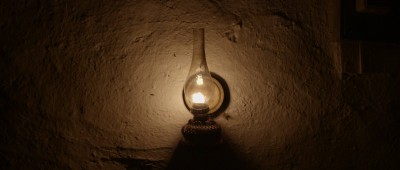
From its very first frame to its measured, quiet, but immensely powerful last, Nuri Bilge Ceylan's Once Upon a Time in Anatolia is a supremely well-controlled, visually transporting work of cinematic art that entices us, with its steady, intense rhythms and its fraught mixture of pessimism and compassion, into seeing the world in a more reflective, penetrating way than we can normally see it through just our two humble eyes. It's paradoxical that Ceylan does this by telling his story, based on a real-life murder investigation and containing the incidental trappings of a police procedural, through the most visual medium available, but it makes the potency of what he's accomplished all the more impressive. When it comes to his unabashedly, cleansingly philosophical concerns about how to be and act in a world with other human beings, Ceylan is a storyteller like Dostoyevsky is a storyteller: That there is a murder case to be solved is only a half-incidental pretext to nudging the door open on, for lack of a better word, the souls of those bureaucratically constrained protagonists conducting the dreary investigation -- the policemen, the lackeys, the district attorney, the doctor, all haunted by what they're going through, but each stuck in their own mode of unsatisfying, painful inadequacy when it comes to relating at all meaningfully to the others, or really to anyone. Cinematically, Ceylan is a storyteller akin to (and, with this film, in the league of) Kiarostami (Certified Copy), Antonioni (L'Avventura), Bresson (Pickpocket), Tarkovsky (Stalker), and other rarified filmmakers who do, old-fashioned as it may seem, use cinema less like postmoderns (as an end in itself) than modernists (as a means to the end of posing, in their own voice and on their own terms, anguished questions about the largest possible moral and ethical matters, the truly life-and-death stuff that all escapism is designed to take our minds off of). In Once Upon a Time in Anatolia, he does this with such visual clarity, grace, and cool beauty, and with such a willing and confident embrace of all the challenging narrative ambiguity and deliberateness of pace that his aesthetic/philosophical goals require, that it doesn't feel reckless or hyperbolic to take the leap and call it a truly great film. Despite its air of ineffable loss, stifled desperation, and never-ending internal struggle with the more sobering mysteries of existence, it gives you hope the way most great art does in one way or another: That someone is still capable of making something so resonant, with such depth, care, and thought and such skillful, intuitive craft, restores your faith, both in cinema and in the possibilities of what we people, as dubious a race as we may sometimes seem, are still, exhilaratingly, able to communicate and give to one another. DVD Talk Collector Series.
|
| Popular Reviews |
| Sponsored Links |
|
|
| Sponsored Links |
|
|
| Release List | Reviews | Shop | Newsletter | Forum | DVD Giveaways | Blu-Ray | Advertise |
|
Copyright 2024 DVDTalk.com All Rights Reserved. Legal Info, Privacy Policy, Terms of Use,
Manage Preferences,
Your Privacy Choices | |||||||














